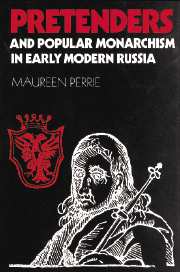Book contents
- Frontmatter
- Contents
- List of illustrations
- Preface
- Note on transliteration, names and dates
- Chronology of events
- Glossary of Russian terms
- List of abbreviations
- Introduction
- Prologue: Tsarevich Dimitry and Boris Godunov
- Part 1 The First False Dimitry
- Part 2 Rebels in the name of Tsar Dimitry
- Part 3 The final stages of the Troubles
- 6 The Second False Dimitry: from Starodub to Tushino
- 7 The Second False Dimitry: Tushino and Kaluga
- 8 Tsarevich Ivan Dimitrievich
- Epilogue: After the Troubles: pretence in the later seventeenth century
- Conclusion
- Bibliography
- Index
7 - The Second False Dimitry: Tushino and Kaluga
Published online by Cambridge University Press: 03 December 2009
- Frontmatter
- Contents
- List of illustrations
- Preface
- Note on transliteration, names and dates
- Chronology of events
- Glossary of Russian terms
- List of abbreviations
- Introduction
- Prologue: Tsarevich Dimitry and Boris Godunov
- Part 1 The First False Dimitry
- Part 2 Rebels in the name of Tsar Dimitry
- Part 3 The final stages of the Troubles
- 6 The Second False Dimitry: from Starodub to Tushino
- 7 The Second False Dimitry: Tushino and Kaluga
- 8 Tsarevich Ivan Dimitrievich
- Epilogue: After the Troubles: pretence in the later seventeenth century
- Conclusion
- Bibliography
- Index
Summary
The Tushino court
The advance of Dimitry's army from Bolkhov towards Moscow in the early summer of 1608 had created alarm and consternation in the capital. According to Bussow, the news that a number of noblemen had defected from Shuiskii's army convinced many Muscovites that the pretender really was Tsar Dimitry, and they feared that he would wreak a terrible vengeance on the city for the events of May 1606. Some ordinary citizens hoped to put all the blame on the boyars, but others feared that Dimitry's extraordinary powers would enable him to discover the true identity of those who had overthrown him:
Someone said, ‘I have heard that he is so clever that he can tell from looking at you whether you're guilty or not’. A certain butcher was very alarmed at this, and said, ‘So much the worse for me. I daren't appear in his sight, for I killed five of his Poles with this very knife’.
Shuiskii was able to use these fears to his advantage. Massa states that, as Dimitry's army approached Moscow,
The tsar contrived to steady the people by his many exhortations, for he swore to them that the enemy would kill all the inhabitants, including women and children, if they surrendered. Since they had all been to some degree accomplices in Dmitry's murder, they once more resolved to stand firm.
- Type
- Chapter
- Information
- Pretenders and Popular Monarchism in Early Modern RussiaThe False Tsars of the Time and Troubles, pp. 182 - 207Publisher: Cambridge University PressPrint publication year: 1995



